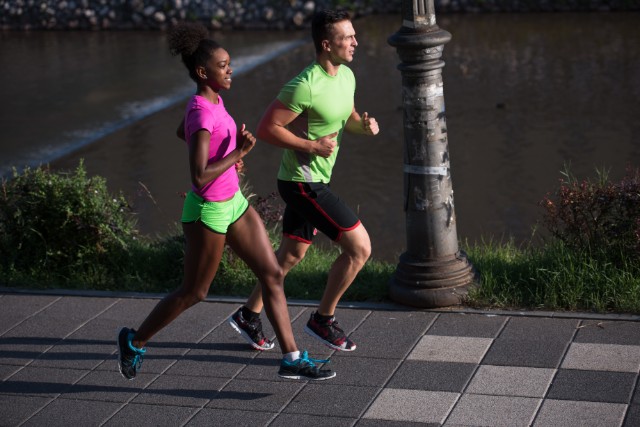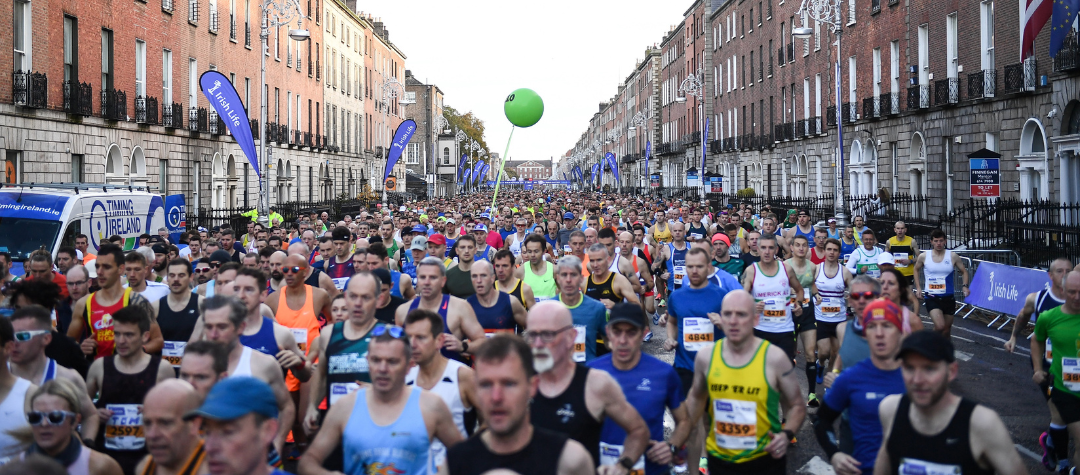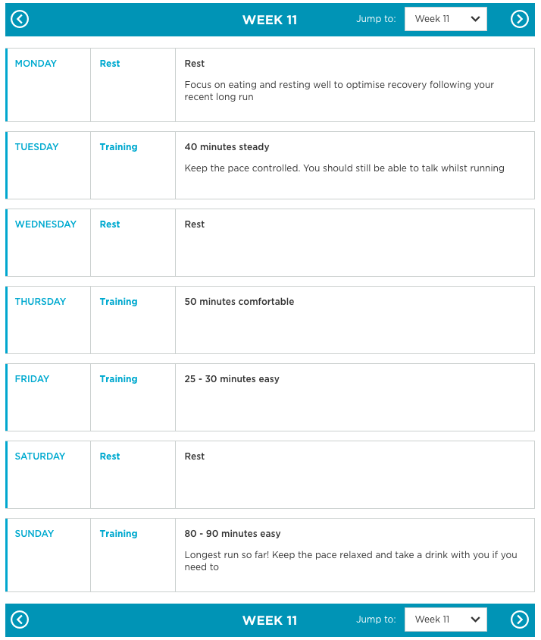Thinking of running a marathon for the first time and need help with your preparation? We can help. Let our ultimate marathon guide answer your training, nutrition, kit and questions in the run up to the big event.
-
It might seem obvious, but at 42.2 km (26.2 miles) the marathon is up there as one of the toughest running challenges in sport, taking the average participant around 4hr 20 mins to complete (terrain and weather dependant). Of course you don’t have to aim for that pace.
Choosing the right marathon for you depends upon personal preference - would you prefer to keep your race flat or hilly? What’s your budget? What season would you want to run and train in? Once that’s ticked off, all that’s left is preparing for the race itself.
It’s not advised to attempt a marathon without proper training. You need to pay close attention to your health. If something doesn’t feel quite right and you need another year to re-familiarise yourself with the world of running, so be it. Your health and safety is top priority. If everything’s A-okay, make a start with your training. If you haven’t exercised for some time then it may be worth getting the go-ahead from your GP before starting training.
How to train for a marathon
The key to training for a marathon is consistency. If you’re new to running, start off slowly. It’s recommended that beginner runners allow themselves around 20-24 weeks of training in order to clock up the necessary distances in training and reach the point where they can successfully complete a marathon.
It’s recommended that beginner runners allow themselves around 20-24 weeks of training in order to clock up the necessary distances.
Don’t overdo do it to begin with. Set yourself the challenge of running at least three times a week, gradually building your base mileage with each training session. For example, if you’re beginner, day one should consist of a brisk walk and an easy run.
Our Marathon Challenge takes you through all the training essentials you need to know on your marathon journey, including training session suggestions, whatever your ability.
Why marathon training is different
The biggest mistake a marathon entrant can make is underestimating how tough the race actually is. 42.2 km is hard going and you need to be at peak health, both physically and mentally to reach the finish line.
Unlike other races, such as 5k running events , where beginner runners are relatively safe in competing without weeks of training beforehand; a marathon requires a significant amount of preparation, including what you fuel your body with. Upping your training schedule naturally means that you need more food to fuel your runs , which you’ll notice if you’ve raced shorter distances in the past.

How to get started
One of the most daunting yet critical points of your marathon journey is getting off to the best possible start. If you’ve entered a marathon and are wondering what to do next, your first step should be to calculate how much time you now have and to set a start/end date.
Then draw up a list of the running kit you need ; see what you have, what you don’t and what you need to buy. Then there’s the running nutrition side of your training - don’t neglect fueling as you prepare for the big event.
Having a knowledge or at least an awareness of what to expect in the upcoming months will help as you start to put together an effective training plan.
Marathon training plan
Don’t pluck a training schedule out of thin air. Your runs should be consistent, a balance between endurance work vs. strength training vs. rest. It should also cater to your running abilities - if you’ve ran half marathon after half marathon in the past, you can increase your weekly running distances sooner than a complete beginner.
Do your best to stick to your training plan. Skipping a run here and there may seem nonessential to begin with, but it can make all the difference on race day. There’s no harm in tweaking your training schedule if you feel like you’re progressing quicker than you initially anticipated. But the worst case scenario is reaching your tapering period and feeling unprepared.
If you haven’t the time to coach yourself, realbuzz have you covered. Our Marathon Challenge does a lot of the hard work for you, providing you with a structured training plan and what to do each day, so you’re ready for your marathon.
When to increase distance
Determining when to increase your distance is completely personal. If everything’s going according to plan, great, keeping bumping up the miles, but don’t divert radically from what’s in your training plan - it’s there for a reason, namely to ensure you train safely.
That being said, remember that consistency is at the heart of your training plan. Don’t go overboard and put yourself in harm's way - an injury could set you back days, if not weeks. This applies to beginners in particular, who need to allow the body time to adjust to longer runs. These training tips to get your marathon ready should help.
Many stick to a 10 percent rule in increasing weekly mileage, but we’d advise that ideally you never exceed this. Beginners, aim to build your weekly mileage up to 50 miles over the 20 weeks or so leading up to your race.
Many stick to a 10 percent rule in increasing weekly mileage, but we’d advise that ideally you never exceed this.
How to increase your speed
If you’ve found a pace you’re happy with and comfortable at, but want to take it one step further and look to improve your speed , look at varying your training sessions. Hill workouts work your body harder and enhance your level of endurance, which in turn, helps you get faster. Alternatively, if you’d prefer to keep it indoors, treadmill training for a marathon can be just as effective. Find the right music to keep you company and it won’t feel as much like a workout.
If you’re new to marathon running, this shouldn’t be top priority - keep working on steadily increasing your mileage. Speed work can bring put you at greater risk of injury if not executed with correct form, so concentrate on getting the necessary amount of miles under your belt.
Training on road vs other terrain
Boredom can get the better of all runners. If you’re starting to feel confident in your run, avoid training monotony by varying running types. A change of environment can challenge you in new ways and bring about great results.

Always liked the idea of cross country running ? Take a break from pounding the pavements and give it your best shot. Alternatively, hit the trails and run off road . The difference in terrain will test your body like you haven’t experienced before and help you to build strength, as well as lessening the risk of injury that you’d get from endless miles on a hard running surface.
Types of training
You are in no way limited to one type of training. There are intervals , hills, tempo runs - pick and choose workouts that complement your marathon training on the whole.
A popular choice for many runners is the VO2 max workout. VO2 max is the maximum amount of oxygen the body can utilise during exercise, and typically, the workout itself consists of long interval sessions that push the heart to its maximum capacity. This in turn, improves your aerobic fitness, making you a more efficient and faster runner. Threshold running is also a popular training option.
Types of running (easy runs, moderate pace, hills etc)
Training for a marathon isn’t all about endless long runs. While long runs are vital to improving your endurance levels in the run up to the big day, there’s no harm slowing your pace down for an easy/moderate run, especially on days when you’re recovering from a heavy training session.
Training for a marathon isn’t all about endless long runs.
Easy runs help to keep your training ticking over. They may seem like a struggle at times if you’re feeling particularly fatigued by an earlier long run, but they are definitely worth including in your training schedule. Keep at a comfortable pace so it doesn’t impact future runs.
Likewise, if you feel that your training plan could benefit from speed work , don’t shy away from it.
Running technique
If you’re running as hard as you can but feel like you aren’t getting anywhere, take a closer look at your running technique . Consider aspects such as how you hold your arms, head, and shoulders as you run.
Another aspect to consider is your stride length and rate. Initially, you gain running momentum in whichever way is natural to you, but there are means of improving your stride rate, and in turn, your running efficiency. The average stride rate for a recreational runner is between 150 - 170 steps per minute, but don’t be too hard on yourself if you’re way off the mark. Try timing yourself to see where you’re up to.

To work on your technique, try downhill stride sessions. Gravity will help you pick up the pace, and you will be able to concentrate more fully on how your feet hit the floor.
Breathing techniques
Take the time to better your breathing technique as you run . Like your legs, your lungs need training too. The deeper you breathe, the greater oxygen flow and as a result, the greater the amount of energy produced. Shallow breaths can leave you with a stitch or feeling lightheaded, which is the last thing you need on race day.
Work on developing a natural rhythm. This could be done of a night time when you’re lying in bed and you’ve time to focus on your breathing. Or alternatively, yoga and Pilates sessions are a great place to pick up breathing techniques.
Rest & recovery
Well timed periods of rest and recovery are essential to your marathon training. Long runs and hard-hitting workouts lead to slight tears in the muscles that repair as you rest-up. This process of rebuilding results in a faster and stronger you, so never neglect your beauty sleep. Without the recommended eight hours, your reaction time, immunity and cognitive functions are the first to suffer.
Without the recommended eight hours, your reaction time, immunity and cognitive functions are the first to suffer.
Signs that you need more rest than you’re currently getting are: increased irritability, increasingly poor workouts, elevated resting heart rate and frequent injury/illness.
Training diet
It’ll probably come as no surprise to you, but a healthy, balanced diet can make all the difference to your running progress. Feed your body junk and it will show in training. You need slow releasing snacks that keep you energised throughout your runs. Then there’s the question of how much and when.
You can keep it simple. Pre-run , eating a banana half an hour before you head out can be a good source of energy. Or if it’s a longer run, a bowl of porridge an hour before you set off can have the same effect. Never eat anything you haven’t tried previously when it comes to your race.
Post-run , eat foods that aid recovery. Recovery smoothies are a popular choice thanks to their nutrient hit. Or for something quick and tasty to kick back with, chocolate milk also makes a great recovery drink. Don’t undo your hard work with a poor diet.
Top tip: where possible, practice rehydrating during training ; not only with water, but also sports drinks and gels for those times when you need an energy boost.

Last weeks and days before the marathon
The final weeks before race day can be the most nerve wracking. You’ve put months of training into this one day; what has it got to take to make sure your race goes to plan ?
To minimise your risk of picking up an injury or becoming unwell, it’s a good idea to stick to what you’ve always done. For example, three weeks before your marathon, don’t suddenly decide to adopt a completely new way of training or diet plan. We repeat, consistency is everything.
Importantly, also try to resist the urge to make up for lost time. If you haven’t committed as much to your training plan as you would have liked and are worried that you won’t make the finish line, tiring yourself out with last-minute workouts isn’t the answer.
To minimise your risk of picking up an injury or becoming unwell, it’s a good idea to stick to what you’ve always done.
Do what you can and get plenty of rest before the event - you will need all the energy you can get for your marathon.
How to taper & mistakes made
Once you hit the two-to-three week countdown to race day, now’s the time to start thinking about tapering . You need to reduce your training hours to ensure that you’re left with enough time to recover and get all the rest you need for your marathon. No training benefits can be gained from these final 14 days, so concentrate on maintaining your current level of fitness.
It’s recommended that you reduce your training load to 60 per cent of your normal volume the week before race day, and then a further 30 per cent in the final week. The last seven days are all about easy runs - less is more. Use this time to relax and eat well and avoid tapering mistakes .
How to stay motivated
You’ve made it this far; don’t let a lack of motivation stop you from reaching your potential on race day. Cast your mind back to the day you entered your marathon and reflect on how far you have come in that space of time. If this is your first marathon , remind yourself of what an incredible achievement you’re about to embark on. If you’re doing it for charity, think of all the people you’re helping by racing.
If this is your first marathon, remind yourself of what an incredible achievement you’re about to embark on.
Before your marathon, dedicate some training time to mental preparation . Visualisation techniques help for some. Imagine how the day will pan out and rehearse the course in your mind. Or even better do your best to mimic the race on your last long run, paying close attention to your pacing, what you wear and what you eat. Knowing that you’ve accomplished it without a glitch in training can be a huge confidence boost on the day.
On race day
How to warm up
You should perfect your runner’s warm up right the way through training. Before a run, dedicate five minutes at the very least to dynamic stretching and increasing blood flow around the body. Many skip the warm up and start training straight away. However, this makes you more susceptible injury and holds you back from performing at your absolute best.
Your warm up doesn’t have to be hard work. Take a brisk walk and turn it into a light jog, followed by stretching the quads, hip flexors and hamstrings.

How to cool down
Once you’ve hit the finish line, the last thing you will feel like doing is cooling down. But you’ll be glad that you did later in the day. Again, a minimum of five minutes should be taken out of your post-marathon celebrations for a gentle jog and stretching session. This helps your breathing and heart rate return to normal, and removes waste products from your muscles, such as lactic acid.
Like your warm up, bring the pace right down for your cool down. Again, a short jog followed by total body stretches will help ease any tensions and get your post-race recovery off to a great start. Check out the basics of warming up and cooling down.
Stretching
If you’re struggling to decide upon stretches for your warm up and cool downs, the best approach is to target each area of the body. That way, you cover all bases and injury-proof your body the best you can. From the back to the quads and hamstrings, set aside 60 seconds for each and stretch the area best you can. Take a look 10 stretches we recommend for runners .
What to eat and drink before your marathon
Before your marathon, make nutrition a top priority.
Before your marathon, make nutrition a top priority. You’re going to be using a high amount of energy during your 42.2k (26.2 miles) so it’s important that you make the best possible food and drink choices in the days leading up to your race.
Ideally, you will have practiced the process of carb-loading around six weeks before the event, so there are no nasty surprises when it comes to your final week preparations. We’re talking lots of pasta, rice and bread; carbs that top up glycogen stores up, ready for race day.
Before the race itself, don’t eat massive amounts as you may regret it. Stick to what you ate in training so you know your body can handle it. If you are struggling for ideas then check out these 10 carb-loading snack and meal suggestions .
What to eat and drink during your marathon
It’s essential that you are strategic when it comes fuelling your marathon . Eating and drinking at the right times not only settles hunger pangs or potential tummy upsets, but it also has the ability to push your run faster and help you achieve your best time yet.

Throughout your race, keep topping up your carbs count with the snacks you trained with - be that energy bars, sports gels or dried fruit. It’s also majorly important that you stay hydrated throughout your marathon. Don’t wait until you get thirsty. Drink little and often rather than lots all at once.
What to eat and drink after your marathon
What you eat after your marathon can play a vital role in your recovery. Yes, you definitely deserve a treat after all your hard work and there’s no harm in celebrating, but if you can be mindful of your post-race recovery as you do so, that’s a bonus.
Your body will have been through a lot over those four hours, so work on replenishing your muscles’ energy stores. Pick a high carb/high protein meal or snack that’s packed with nutrients. In the 24 hours that follow, also drink plenty of water and the odd sports drink containing electrolytes where possible. Check out the race recovery plan for runners for nutrition ideas for post-race recovery.
In the 24 hours that follow, also drink plenty of water and the odd sports drink containing electrolytes where possible.
What if you need to go to the toilet during your marathon (e.g. Paula Radcliffe)
If you stick to what worked for you in training, everything should be fine. However, if you have eaten something that has irritated your stomach or you haven’t managed to stay hydrated, you may feel some discomfort that requires an emergency toilet break.
Tip one: Always go before you race. But if not, in most instances, there should be portaloos dotted around the course. If you’re running in a city and the portaloos have long queues, there may be pubs and restaurants en route with facilities you could use. Be aware that the portaloos are pretty popular, so it’s wise to take some tissues of your own with you just in case.
Dealing with pains/injuries
1. Knee pain
Sometimes running injuries just happen. But if you deal with them efficiently from the start, they may not interfere with your running training too much. The worst thing you can do is ignore the issue and continue training with an injury; that will only exacerbate the problem. Rest as much as you can and visit your doctor or a physiotherapist when necessary.
One of the most common injuries runner’s face is knee pain or ‘runner’s knee.’ Being a high impact sport, the knee joint is often first hit by lengthy training sessions. There can be numerous reasons behind the pain - it could be swelling or a breakdown in cartilage, or simply as a result of wearing the wrong running shoes. The pain can vary from a dull ache to sharp stabbing pains as you move. Find out about some other common running injuries .
2. Stitches and cramps
Another pain that runner’s face is the dreaded stitch, or worse still, cramp. Again, these types of issues are often preventable through the right food and drink choices and well timed fuelling. It’s hard to determine the reason why we get stitches, but many believe it’s as a result of eating too closely to training. Try eating a little earlier to see if this helps. Similarly, cramp can be caused by dehydration, so remember to drink enough water before heading out.
If you’re out on a run and a stitch or cramp catches you by surprise, there are ways of dealing with the pain. For a stitch, slow down and allow time for it to pass. Deep breaths can really help in this instance too. With cramp, stretching is the best means of alleviating the pain. Find out ways to deal with cramp and other issues that could affect you during your race.
What to wear when running a marathon
If you’re taking your marathon running seriously, it’s worth investing in kit that keeps you comfortable throughout your race. Running a marathon is taxing enough without the added complications of a wardrobe malfunction. It’s wise to be prepared for your race, whatever the weather.
For men
If your marathon takes place during the day and is expected to have clear conditions, choose a short sleeve t-shirt and shorts for your race. If the sun’s out, don’t forget to wear sunglasses and apply sunscreen.
However, if the weather takes a turn for the worse, be prepared to dig out a light waterproof jacket, leggings, a long sleeved t-shirt and gloves. Your marathon look is very weather dependant. Also, a note to male runners : watch out for chafing. There are products available that create a barrier between the nipples and your t-shirt, or alternatively, have some anti-chafe moisturiser to hand.

For women
Similar to the kit suggested for male runners; ladies heading out in clear conditions should stick to shorts and a short sleeved t-shirt, but keep extra layers to hand just in case the temperature dips - again, leggings, hat, gloves and a light waterproof jacket. In addition to the women’s kit suggestions above, women also need to shop for a good quality sports bra . This provides extra support and comfort to your run, in addition to reducing your risk of injury.
Ideal running clothing
Don’t run in cotton clothing. When shopping for your marathon wardrobe, opt for technical fabrics such as CoolMax - this material helps draw perspiration away from the skin through its fibres, keeping you at a comfortable temperature throughout your marathon. Before your race, run in what you think you’ll be wearing on the day, just to ensure that you aren’t wearing anything that irritates the skin.
Also, don’t forget your feet. Investing in a good pair of runnning socks can help prevent blisters and soreness during your run. I










